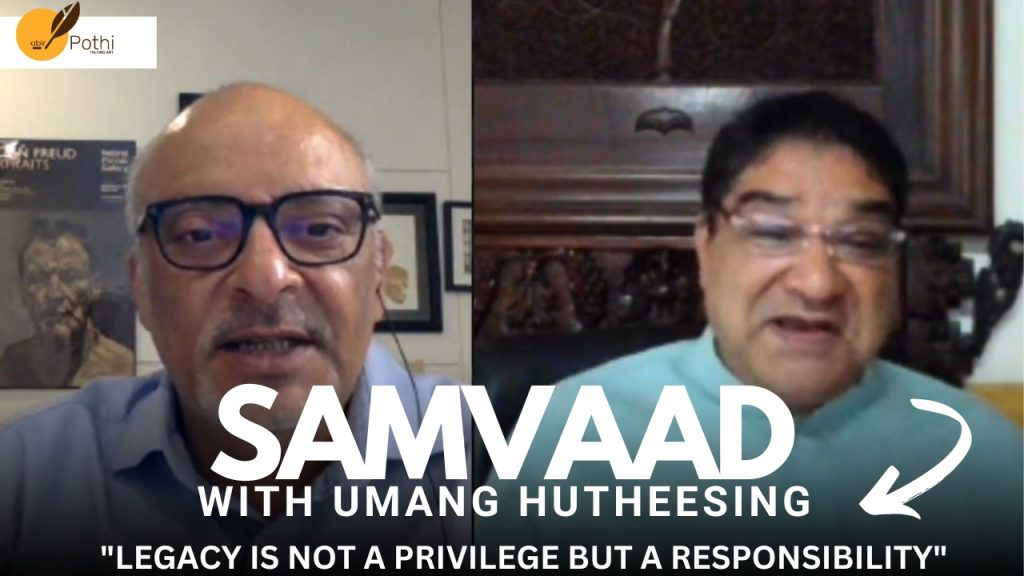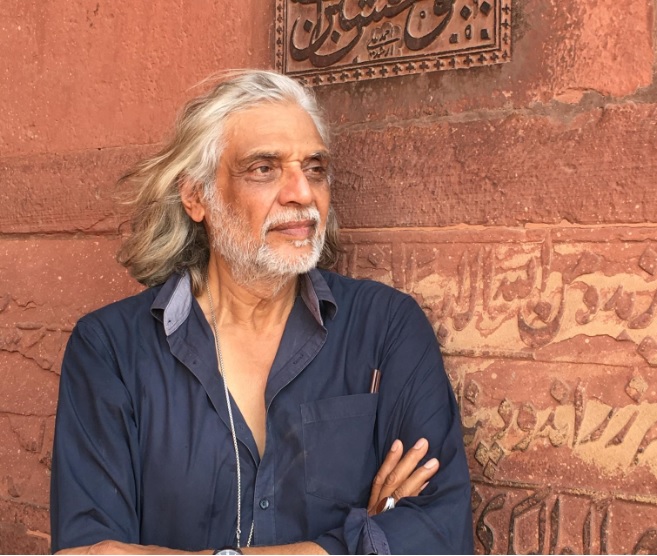Welcome to Samvaad, where art meets conversation, and inspiration knows no bounds. Here we engage in insightful conversations with eminent personalities from the art fraternity. Through Samvaad, Abir Pothi aims to create a platform for thought-provoking discussions, providing readers with an exclusive glimpse into the creative processes, inspirations, and experiences of these creative individuals. From curating groundbreaking exhibitions to pushing the boundaries of artistic expression, our interviews shed light on the diverse perspectives and contributions of these art luminaries. Samvaad is your ticket to connect with the visionaries who breathe life into the art world, offering unique insights and behind-the-scenes glimpses into their fascinating journeys.
This is part 5 of the Samvaad between Nidheesh Tyagi from Abir and Umang Hutheesing, the founder and president of the Hutheesing heritage foundation. Umang Hutheesing is on the governing board of the Ahmedabad Education Society, a managing trustee of the Hutheesing Visual Art Centre, and most importantly is the president and fifth generation of Hutheesing to manage the Hutheesing Design Company and Studio from the very same historic location, Jaising bhai-ni-wadi. He is also the founder and president of the Hutheesing heritage foundation which has restored the Hutheesing Haveli and preserves the Hutheesing art collection. He has collaborated with the international foundation Musée Yves Saint Laurent in Paris and the National Museum of Bahrain, the Baroque Museum in Mexico, the Miho Museum in Japan, and the Chhatrapati Shivaji Vaastu Sangrahalya in Mumbai, where he has exhibited over 300 pieces showcasing the cultural heritage designed by him from the Hutheesing collection.
Nidheesh: yes with that detailing and context, is just not easy, it’s a serious thing. You’ve been a part of Abir as a jury, and you’ve been a great support and helping us with your space for organizing our annual show for Abir India, so what’s your perspective about Abir? Because this is going to be especially useful because lots of our artists, are emerging and having somebody like you give them a perspective to be very, very helpful.
Umang: let me tell you. My relationship with Abir started from its first show and what drew me was the inclusiveness of Abir. See, we are a physical institute that is landlocked in a place. Abir was a bird with wings to fly across India. But, we did a nest. So, it became a very lovely partnership where we provided the incubation and the birds flew across the country. It reached out to people everywhere. I am so proud every time I hear Ruby telling me that we got entries from remote, we got entries from Andaman I mean this is fascinating and this technology is important to reach out to each Indian. I am not there to judge whether it is good or bad, my judgement is limited, and my vision is inclusiveness and involvement of everybody. The little chicken loves to fly. Let them involve, let them encourage and this is the time to fly. We are a young nation.
Nidheesh: so, what are the lessons you will give them?
Umang: Do not be afraid. Creativity never comes from fear. Creativity comes from confidence. Believe in yourself and do what your mind wants you to do. It will grow, allow it to grow and if other people judge. Let them keep open to themselves. Do it as your own belief and your own pleasure. I mean, that is how great artists are created.
Nidheesh: and how do you see this, since you’ve been a witness and a participant and an observer to this whole journey from 2003 when I spoke to you, forty-five years of the visual art centre and before that, you had a great heritage and inheritance. How do you see the art journey of India going, what is your take on it?
Umang: if we observe where art is going like any, like if you look at China or Japan after the wars when they were a poor nation, and then they made the cheapest products. India will also reach there, and Indian art will be there. From the progressive art group, we took Picasso. Tyeb Mehta arose from there, in fact, Ravi Verma is being appreciated more now. Twenty years ago how many knew about Ravi Verma? Look in India, M.F. Hussain one was the most expensive artist in India and I respect him greatly. But, if you see solely M.F. Hussain’s work is not a national treasure; it can be bought and sold internationally. Nandlal Bose and Gangandranath Tagore are national treasures and Anrita Shergill. These artworks were slowly being rediscovered by India. The Bengal School was the Renaissance of Indian Art. As we move back to the history of art, you’ll find that one time will come when Indian miniatures including Raag Ragini will be understood. The Kangra school, the Pahari school, the Kishangarh school, and the Bundi School. These were the great portraits of the royal families and privileged classes to create art and culture in India. So as Indian music is getting popular, Indian clothing will become popular, Indian art will become popular, and we are not dependent on any colonial power or any foreign country to buy our products.
Nidheesh: or validate us.
Umang: we are a powerful economy, the largest populated country democracy in the world buying our own product. Understanding it, loving it and enjoying it.
Nidheesh: thank you. I think we had a great conversation with you, and it has been very enriching and amazing anecdotes from your own vast history and past and your contribution. Also, this fabulous design company which I think oldest in Asia and then connecting with the art and design world. Thank you so much Umag Hutheesing Ji.
Umang: I am very happy and proud of Ruby Behen, a very humble and charming lady to create Abir with passion and patriotism. She is an artist herself, working with natural dye, and she is not focusing on promoting herself but taking young artists of India to the larger platform. So, I must give her a great applause, and a great sense of appreciation.
Nidheesh: thank you so much for your time.
Umang: just last words, do not create art with fear, create with passion and take the country forward.
Nidheesh: conviction and authenticity. Thank you.
Transcribed by Abhishek Dixit





